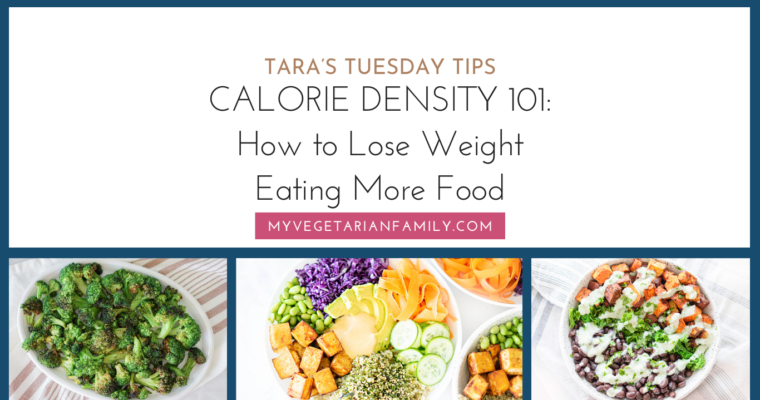If you have ever looked at your plate & wondered if you are getting it right, my tips this week will help! Learn how to eat as a vegetarian to make sure you are happy with what is on (and off) your plate to keep you nourished + satisfied. Let’s learn how to build a healthy vegetarian plate together using the plate method.
Tara’s Tuesday Tips:
How to Build a Healthy Vegetarian Plate
The Plate Method is an easy shortcut to help you create + plate balanced, nutritious, satisfying meatless meals. Learning how to build a healthy vegetarian plate doesn’t have to be complicated or cumbersome. You don’t need meticulous measurements, scales, or rules. This method is helpful for anyone wondering if they are getting it right, or looking to eat more healthy plant-based meals, or to lose weight, or to ditch diet mentality. Whatever your reason, I’m so glad you are here, let’s do this!
Let’s Start With the Basics:
What Does it Mean to be Vegetarian?
A vegetarian does not eat meat. Some vegetarians choose not to eat or use other animal products as well. This choice is made for religious, moral, ethical, environmental, or health reasons.
What Foods Do Vegetarians Leave Off Their Plate?
Meat products including seafood, beef, pork, chicken, turkey, and any other flesh or body part of any other animal/living creature are left off a vegetarian plate. Some vegetarians choose not to eat dairy or eggs. A lacto-vegetarian does not eat meat or eggs but consumes dairy products. An ovo-vegetarian consumes eggs but not dairy or meat. A lacto-ovo vegetarian leaves the meat and seafood off their plate but does leave room for dairy and eggs on their plate.
What is The Plate Method?
The Plate Method is a visual way of guiding you to divide up your plate + fill it in a way that keeps you nourished + satisfied. It allows you to visualize the different food groups to easily allow you to fill in the parts of the plate + balance your meal. Each time you make a meal, think of dividing your plate into three parts: non-starchy fruits + vegetables, protein, and starches. The purpose is NOT to become meticulous with fractions and portions and measurements. The purpose IS to aim to cover the basics when you make a “plate” and recognize if you’ve covered the basics when you sit for a meal with a plate. If we know we’ve covered the food groups in the majority of our meals, we can be flexible + recognize that sometimes our bowls or cups or even plates won’t align with the plate method, and that is totally ok!
This method is a spinoff from MyPlate, a USDA Guideline.

The Plate Method Breakdown:
Vegetables + Fruits
- Half of your plate should be as colorful as possible, loaded up with fresh or frozen non-starchy fruits + veggies. These are what give you fiber, antioxidants, vitamins, and minerals.
Protein
- ¼ of your plate should be plant-based proteins. These include legumes, tofu, tempeh, nuts, seeds, edamame, peas + pea protein products, soy + soy milks. If you consume dairy or eggs, this is the part of the plate for these foods.
Starches + Grains
- The remaining ¼ of your plate needs to be grains, preferably whole grains, but whatever fits for you. Options include oats, rice, quinoa, bread, pasta, corn, potatoes, and squash.
Where Do Fats Fit?
Fats are important! Fats fit in on the side or on the top of the plate. Whole food sources over oils are preferred. Fats are a crucial part of our plates as they help us absorb the vitamins in the other foods we are eating, keep us full and satisfied, and plant-based sources are often high in fiber. Fats include avocados, avocado oil, nuts, nut butters, olives, olive oil, tahini, coconut flesh + milk + oil.
Other Things on the Side of the Plate
In addition to the plant-based fats, on the side of the plate are any supplements you might be taking (B-12, iron, calcium, omega-s’s), and calcium-fortified plant-derived dairy products.
Food For Thought
Think of the plate method as a mental checklist that you go through when you plate your meal. Ask yourself, what is missing, do I have ¼ + ¼ + ½? When trying to eat healthier, lose weight, get more of a certain nutrient, we always think of what we need to take away. The plate method allows you to shift your mindset to what you can put ON your plate instead of what you need to take OFF your plate. If you’ve read my articles before, you know I am not a fan of rules or restriction or measurements. This solves that problem!
First, think about what you can add not subtract. Next, aim for getting your plate right 80% of the time leaving 20% for the fun/social/yummy foods that make food more than food. Food is way more than just a tally of nutrients + fat + calories. I hope the plate method gives you a tool in your toolbox to make that a little easier to see. Above all, enjoy good food in the company of good people – in a plate or a bowl or a cup or on a spoon!
All the best,
Tara 👩🏻🌾💚

Looking For More Tips?
head on over to one of these …
The Vegetarian’s Guide to the 80/20 Diet
How to Eat Healthy Without Counting Calories as a Vegetarian
Hacks to Hit Your Protein Goals as a Vegetarian
Improve Your Health By Adding Not Subtracting
The Vegetarian’s Guide to Stop Dieting
⭐️Did you enjoy learning how to build a healthy vegetarian plate? Leave a comment below, I love to hear from you! ⭐️
📷I love to see your creations! Tag @myvegetarianfamily on Instagram and hashtag it #myvegetarianfamily
💚Be sure to subscribe here to my weekly emails for tips and recipes so that you never miss a veggie thing!


